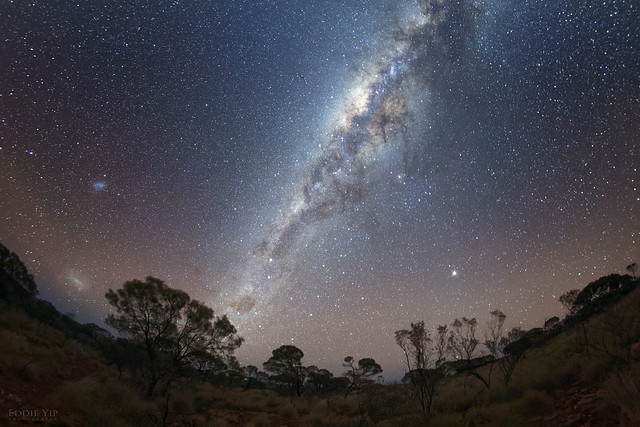
The geographic and economic landscape of northern Australia, as well as its history and ecology, differ in fundamental ways from southern Australia with its large cities and well-connected inhabitants. Sparsely populated, the north typically has vast open spaces with little infrastructure. Many Australians living in the north actually live closer to some of the world’s fastest growing economies with densely populated cities than they do to southern Australian cities.
A common theme among the residents of Asia and Australia, including our traditional owners, is the embrace of new space-enabled technologies that improve quality of life and social connectivity. Consumers need space technology for GPS and satellite TV, and it plays a role in bushfire protection, weather monitoring and providing essential communications and services to the public.
Countries in the region are now acquiring their own space assets while also leveraging off increasing global space capabilities. Space industry momentum in these countries is growing their national power. But facing deep strategic competition between China and the US, many Asian nations are seeking alternative sources for the supply of space services. This presents opportunities for the Australian space industry to offer new options for access to space and associated services for billions of potential customers.
There are two key parts to the space industry.
Upstream providers of technology send objects into space and do space exploration. This includes satellite system developers; component and materials suppliers; ground segment operators and suppliers; researchers and consultants; and suppliers of space products and services.
Downstream exploiters of technology use upstream technology and research—for example, earth observation providers, equipment suppliers, and providers of support products and services.
The space industry comprises all organisations, or parts thereof, engaging in any space-related activity. Commercial organisations earn revenue from the manufacture, launch and operation of satellites and spacecraft, and from using signals and data supplied by satellites and spacecraft to develop valued-added applications such as mobile phone communications and earth observation. Non-commercial organisations contribute space-specific research and expertise throughout the industry supply chain—often in partnership with commercial organisations. These include civilian space agencies such as NASA, defence and national security agencies, and universities and research institutions.
Launch companies are potentially the highest revenue earners in the industry. A SpaceX launch can cost around
US$90 million, and a relatively small RocketLab Electron launch from New Zealand would still cost
US$4.9 million. In 2030, with the growth in the global demand for launch services, Australia could conservatively be generating over US$1 billion per year of export revenue from launches. This capability would also keep funds in Australia that would otherwise be going offshore to foreign launch sites.
The great benefit in launching from northern Australia is the additional velocity imparted to a rocket when it is launched to the east at low latitudes. This means extra payload can be carried in lieu of fuel. From Gove near
Equatorial Launch Australia’s Arnhem Space Centre, the earth’s rotational velocity is 1,637 kilometres per hour, a third faster than the speed of sound.
NASA’s planned launches from the Arnhem Space Centre in mid-2020 will bring international attention to northern Australia’s fledgling space industry. A coup for Australia, this will be the first time NASA has used an international commercial spaceport for launches and culminates from four years of discussions. Follow-on research missions are expected with NASA and other regional space agencies. The head of the Australian Space Agency,
Dr Megan Clark, recently said, ‘NASA’s interest in conducting a sounding rocket campaign in Australia shows the increasing importance of commercial launch activities from Australia.’
An interesting addition to the north’s space industry is the
Airbus Zephyr solar-powered unmanned aircraft. The Zephyr is now flying from Wyndham airfield in Western Australia. The airfield is the world’s first operational site for the launch and recovery of the class of unmanned aircraft known as high-altitude pseudo-satellites, or HAPS. The Zephyr typically flies for days or weeks at a time without landing and operates at very high altitudes. Although not technically in space, the Zephyr can carry communication and observation payloads typically found in satellites.
The north’s space industry will soon include
an Indigenous-owned satellite ground station.
Viasat plans to launch a real-time earth facility in Alice Springs, in partnership with the
Centre for Appropriate Technology Ltd, an Aboriginal not-for-profit science and technology company. The investment will enable Alice Springs to be a key player in the burgeoning global satellite and space industry, and Indigenous Australians to be leading participants in the sector.
The mostly clear skies of the northern outback provide the opportunity to use the visual spectrum to track objects in space and perhaps eventually to
communicate with satellites using lasers.
Lockheed Martin Space and Perth’s Curtin University have adopted the technology used to observe meteorite fireballs and applied it to track satellites. The
FireOPAL project uses a range of sensors to track satellites and space debris and could ultimately provide a persistent view of objects in orbit. Extending this network to northern Australia would further enhance Australia’s space surveillance capabilities.
In the future, our clear northern skies could facilitate the reliable anchoring of high-performance optical space networks. The
European Data Relay System currently uses lasers to communicate between satellites, HAPS and ground stations.
NASA has recently demonstrated laser communications between two small orbiting cubesats more than 2,400 kilometres apart.
Reflecting the need for guidance to the space industry, in April the Australian Space Agency released the
Australian civil space strategy. This follows the release of similar documents commissioned by the
Northern Territory,
Queensland and
Western Australia highlighting their space capabilities. With the support of their governments, northern Australians are now well positioned to leverage significant commercial advantage arising from upstream and downstream opportunities in the rapidly growing global space industry.
 Print This Post
Print This Post